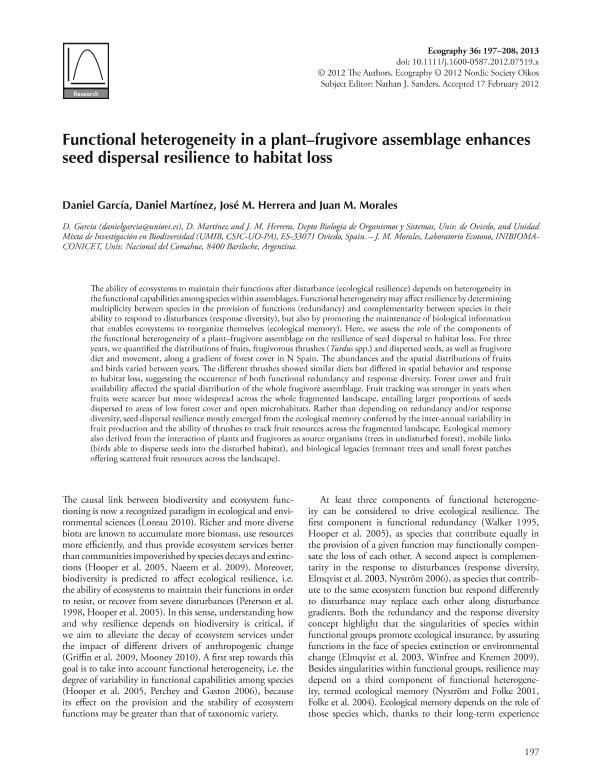Mostrar el registro sencillo del ítem
dc.contributor.author
García, Daniel
dc.contributor.author
Martinez, Daniel
dc.contributor.author
Herrera, J. M.
dc.contributor.author
Morales, Juan Manuel

dc.date.available
2016-07-26T19:40:16Z
dc.date.issued
2013-02
dc.identifier.citation
García, Daniel; Martinez, Daniel; Herrera, J. M.; Morales, Juan Manuel; Functional heterogeneity in a plant–frugivore assemblage enhances seed dispersal resilience to habitat loss; Wiley; Ecography; 36; 2; 2-2013; 197-208
dc.identifier.issn
0906-7590
dc.identifier.uri
http://hdl.handle.net/11336/6702
dc.description.abstract
The ability of ecosystems to maintain their functions after disturbance (ecological resilience) depends on heterogeneity in the functional capabilities among species within assemblages. Functional heterogeneity may affect resilience by determining multiplicity between species in the provision of functions (redundancy) and complementarity between species in their ability to respond to disturbances (response diversity), but also by promoting the maintenance of biological information that enables ecosystems to reorganize themselves (ecological memory). Here, we assess the role of the components of the functional heterogeneity of a plant–frugivore assemblage on the resilience of seed dispersal to habitat loss. For three years, we quantified the distributions of fruits, frugivorous thrushes (Turdus spp.) and dispersed seeds, as well as frugivore diet and movement, along a gradient of forest cover in N Spain. The abundances and the spatial distributions of fruits and birds varied between years. The different thrushes showed similar diets but differed in spatial behavior and response to habitat loss, suggesting the occurrence of both functional redundancy and response diversity. Forest cover and fruit availability affected the spatial distribution of the whole frugivore assemblage. Fruit tracking was stronger in years when fruits were scarcer but more widespread across the whole fragmented landscape, entailing larger proportions of seeds dispersed to areas of low forest cover and open microhabitats. Rather than depending on redundancy and/or response diversity, seed dispersal resilience mostly emerged from the ecological memory conferred by the inter-annual variability in fruit production and the ability of thrushes to track fruit resources across the fragmented landscape. Ecological memory also derived from the interaction of plants and frugivores as source organisms (trees in undisturbed forest), mobile links (birds able to disperse seeds into the disturbed habitat), and biological legacies (remnant trees and small forest patches offering scattered fruit resources across the landscape).
dc.format
application/pdf
dc.language.iso
eng
dc.publisher
Wiley

dc.rights
info:eu-repo/semantics/openAccess
dc.rights.uri
https://creativecommons.org/licenses/by-nc-sa/2.5/ar/
dc.subject
Dispersal
dc.subject
Behavior
dc.subject
Turdus
dc.subject.classification
Ecología

dc.subject.classification
Ciencias Biológicas

dc.subject.classification
CIENCIAS NATURALES Y EXACTAS

dc.title
Functional heterogeneity in a plant–frugivore assemblage enhances seed dispersal resilience to habitat loss
dc.type
info:eu-repo/semantics/article
dc.type
info:ar-repo/semantics/artículo
dc.type
info:eu-repo/semantics/publishedVersion
dc.date.updated
2016-07-22T18:51:42Z
dc.journal.volume
36
dc.journal.number
2
dc.journal.pagination
197-208
dc.journal.pais
Estados Unidos

dc.journal.ciudad
Hoboken
dc.description.fil
Fil: García, Daniel. Universidad de Oviedo; España. Consejo Superior de Investigaciones Científicas. Unidad Mixta de Investigacion en Biodiversidad; España
dc.description.fil
Fil: Martinez, Daniel. Universidad de Oviedo; España. Consejo Superior de Investigaciones Científicas. Unidad Mixta de Investigacion en Biodiversidad; España
dc.description.fil
Fil: Herrera, J. M.. Universidad de Oviedo; España. Consejo Superior de Investigaciones Científicas. Unidad Mixta de Investigacion en Biodiversidad; España
dc.description.fil
Fil: Morales, Juan Manuel. Universidad Nacional del Comahue. Centro Regional Universitario Bariloche. Laboratorio de Ecotono; Argentina. Consejo Nacional de Investigaciones Científicas y Técnicas. Centro Científico Tecnológico Patagonia Norte. Instituto de Investigación en Biodiversidad y Medioambiente; Argentina
dc.journal.title
Ecography

dc.relation.alternativeid
info:eu-repo/semantics/altIdentifier/url/http://onlinelibrary.wiley.com/doi/10.1111/j.1600-0587.2012.07519.x/abstract
dc.relation.alternativeid
info:eu-repo/semantics/altIdentifier/doi/10.1111/j.1600-0587.2012.07519.x
dc.relation.alternativeid
info:eu-repo/semantics/altIdentifier/doi/http://dx.doi.org/10.1111/j.1600-0587.2012.07519.x
Archivos asociados
